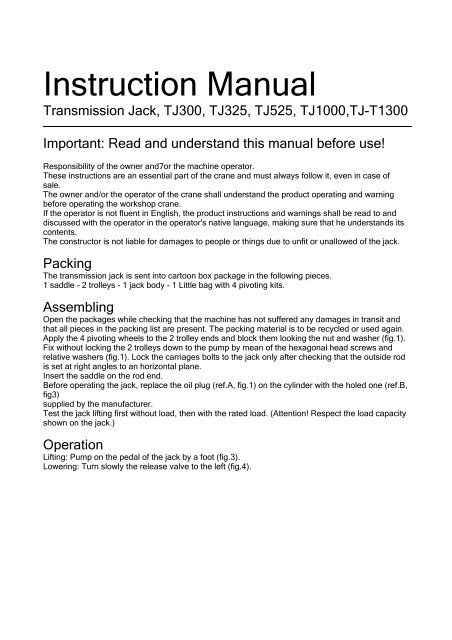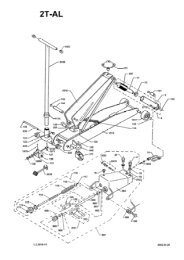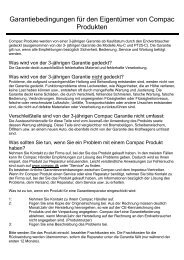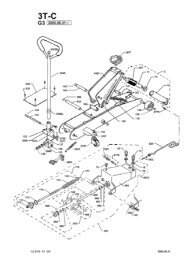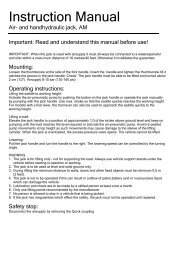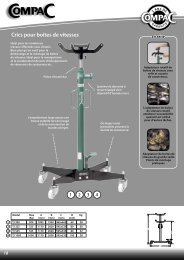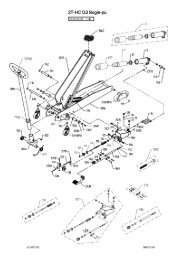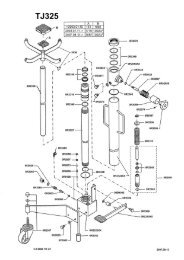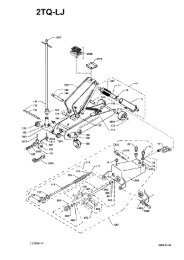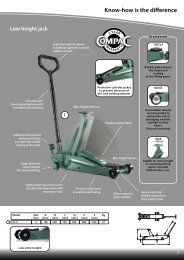TJ300, TJ325, TJ525 And TJ1000 GB - CompaC
TJ300, TJ325, TJ525 And TJ1000 GB - CompaC
TJ300, TJ325, TJ525 And TJ1000 GB - CompaC
You also want an ePaper? Increase the reach of your titles
YUMPU automatically turns print PDFs into web optimized ePapers that Google loves.
Instruction Manual<br />
Transmission Jack, <strong>TJ300</strong>, <strong>TJ325</strong>, <strong>TJ525</strong>, <strong>TJ1000</strong>,TJ-T1300<br />
Important: Read and understand this manual before use!<br />
Responsibility of the owner and7or the machine operator.<br />
These instructions are an essential part of the crane and must always follow it, even in case of<br />
sale.<br />
The owner and/or the operator of the crane shall understand the product operating and warning<br />
before operating the workshop crane.<br />
If the operator is not fluent in English, the product instructions and warnings shall be read to and<br />
discussed with the operator in the operator's native language, making sure that he understands its<br />
contents.<br />
The constructor is not liable for damages to people or things due to unfit or unallowed of the jack.<br />
Packing<br />
The transmission jack is sent into cartoon box package in the following pieces.<br />
1 saddle - 2 trolleys - 1 jack body - 1 Little bag with 4 pivoting kits.<br />
Assembling<br />
Open the packages while checking that the machine has not suffered any damages in transit and<br />
that all pieces in the packing list are present. The packing material is to be recycled or used again.<br />
Apply the 4 pivoting wheels to the 2 trolley ends and block them looking the nut and washer (fig.1).<br />
Fix without locking the 2 trolleys down to the pump by mean of the hexagonal head screws and<br />
relative washers (fig.1). Lock the carriages bolts to the jack only after checking that the outside rod<br />
is set at right angles to an horizontal plane.<br />
Insert the saddle on the rod end.<br />
Before operating the jack, replace the oil plug (ref.A, fig.1) on the cylinder with the holed one (ref.B,<br />
fig3)<br />
supplied by the manufacturer.<br />
Test the jack lifting first without load, then with the rated load. (Attention! Respect the load capacity<br />
shown on the jack.)<br />
Operation<br />
Lifting: Pump on the pedal of the jack by a foot (fig.3).<br />
Lowering: Turn slowly the release valve to the left (fig.4).
Safety:<br />
The use of this jack is limited to the removal and installation of transmissions and differentials.<br />
When loaded, the transmission jack may be used on a short flat way and only with the jack in the<br />
lowest position, with the rod completely inside (fig.5). Check that during transport the load do not<br />
swing and suddenly fall.<br />
Do not overload! Overloading may cause damages to persons or things.<br />
It may be used with appropriate adapters manufactured especially for the jack to handle other<br />
components, such as rear units and transfers cases, within the limitations specified.<br />
Be sure that the vehicle is appropriately before repairs.<br />
Warning:<br />
Avoid decentral placement of the gravity of the load.<br />
Decentral placement of the load might cause overturning of the damage to the jack.<br />
This jack is designed for use on hard level surfaces capable of the load. Use on other than<br />
surfaces can result in jack instability and possible loss load (fig.5).<br />
The safety valve is calibrated and sealed by manufacturer; it is absolutely forbidden to tamper with<br />
this valve or change its calibration.<br />
Failure to heed this warning may result in loss of the load, damage to the jack and/or failure<br />
resulting in personal injury or property damage.<br />
Maintenance:<br />
The hydraulic system (pump/cylinder) is a sealed system, that requires only of the moving parts. In<br />
the hydraulic unit leaks oil or has to be dismantled for gasket replacement, you need to make the<br />
pump working and slowly add through the filling hole. When the transmission jack is in the lowest<br />
position. The oil level should not exceed the filling cap level. For dismantling apply to authorised<br />
people.<br />
Required quantity of oil: 0.95 lt.<br />
The hydraulic system contain enough oil when the jack reaches the reaches highest position.<br />
Warning:<br />
A surplus of oil might cause troubles.<br />
Use any hydraulic oil of gradation ISO32 (ref. Shell Tellus T37 or equivalent). NEVER USE BRAKE<br />
FLUID.<br />
Oil the pedal mechanical parts every 2 months with an high quality oil and grease the head<br />
pumping element. In case of leaking from the hydraulic system replace the seals.<br />
Inspections:<br />
Before using each jack should be checked to leaks, damages, missing, loose and worn parts.<br />
Each jack shall be inspected immediately if it is believed to have been subject to an abnormal load<br />
or shock. It is recommended that this inspection be made supplier's skilled personnel.<br />
It is recommended that an annual inspection of the jack made by a suppliers authorised specialist<br />
and that defective and dangerous parts must be replaced with original spare parts supplied by the<br />
manufacturer (see spare parts list).<br />
Damaged jacks:<br />
Every damaged very used or abnormally operating jack shall be removed from service.<br />
Jacks destruction:<br />
When the jack must be destructed materials must be recycled according to the country law in force.


